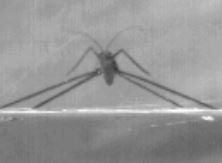Department News
Professor Ho-young Kim's research team uncovers the principle behind giant water striders' water leaps
Author
익명
Date
2023-09-12
Views
337

An international joint research team composed of our Department’s Professor Ho-young Kim's research team (Dr. Jaehong Lee, Professor Hoyoung Kim), the Department of Life Sciences (Dr. Woojoo Kim, Dr. Jeongmoon Ha, PhD candidate Jinseok Park, Professor Piotr Jabwonski), Daegu Gyeongbuk Institute of Science and Technology (DGIST; Professor Sangim Lee), Ecole Polytechnique of France (PhD student Juliette Amauger), Vietnam Academy of Science and Technology (Professor Thai Hong Pham), and Vietnam National University (Professor Anh Duc Tran) announced the 20th that they have identified the principle of the water leap of a giant water strider, which has a leg length of 10 cm and 10 times the weight of an ordinary water strider.

Water striders are known to be representative semi-aquatic insects that live water and use surface tension. Representative natural enemies of water striders are fish or aquatic insects such as swimming crabs, which mainly attack water striders from under the water. Accordingly, the water strider kicks and leaps across the surface of the water to avoid the predator's attack.
The joint research team previously revealed the leaping principle by which a normal-sized water strider efficiently uses surface tension. The results have been published in the world-renowned academic journals Science and Nature Communications. At the time, research showed that regular-sized water striders optimize their leap speed and delay by adjusting their leg speed to avoid breaking the water superficial tension when jumping.
In this study, we studied the giant water strider (Gigantometra gigas), where these existing principles do not apply. The giant water striders living in Vietnam and other places are about 10 times the size of regular water striders, and the research team discovered that unlike regular-sized water striders, these giant water striders take off by breaking the surface of the water.
Through a simulation using behavioral analysis and mathematical models, the research team said, 'Giant water striders are too large to usely existing surface tension jumps, so they cannot produce sufficient jumping performance, then they break the water at high speed and use surface tension and water resistance together’. It was discovered that the giant water strider moves its legs quickly to cut through the water and jumps under the drag of the water like a paddle.
The research team, which has been conducting interdisciplinary joint research for several years between biologists and engineers, "uncovered the water leaping mechanism of the giant water strider, which is completely different from existing principles. This means that even if neighboring species perform the same behavior, the operating principle is completely different depending body size." “This is a very important discovery from an engineering and evolutionary perspective,” he said. The explanation is that as water striders adapted to a life of water and divided into several species, their body size changed and the way they used water changed.
In addition, the research team added, "It has not been easy to create a micro robot imitating a water strider that is the same size as an actual water strider, but if we copy the leaping principle of a giant water strider, we can create a robot that jumps much higher above the water even if its size is not small."
The results of this research were published the 18th in the international academic journal Proceedings of the National Academy of Sciences of the United State of America.
Seoul National University, DGIST, Vietnam, and France research team uncovers the principle of giant water striders leaping from the water - IT Chosun > Mobility > Science, Space, Aviation (chosun.com)

